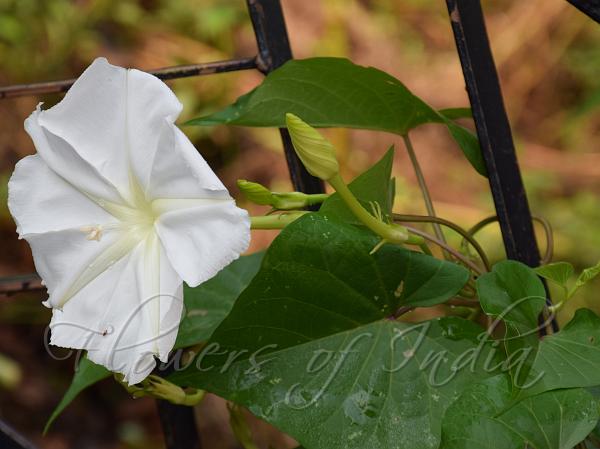|
| Moon Vine |
|

|

| File size | 434249 |
| Original date | 9/8/17 8:52 AM |
| Resolution | 2048 x 1536 |
| Flash | Flash did not fire, auto |
| Focal length | 122.0mm |
| Exposure time | 1/250s |
| Aperture | 8.0 |
| Focus Distance | |
| Metering Mode | Multi-segment |
| Camera make | NIKON CORPORATION |
| Camera model | NIKON D5300 |
| Sensor type | OneChipColorArea |
|
|
|
|
Photo: |
Botanical name: Ipomoea alba Family: Convolvulaceae (Morning glory family)
Synonyms: Ipomoea grandiflora Roxb., Ipomoea longiflora, Ipomoea noctiflora
Synonyms: Ipomoea grandiflora Roxb., Ipomoea longiflora, Ipomoea noctiflora
Moon Vine is a perennial, herbaceous liana growing to
a height of 5-30 m tall with twining stems. The name moonflower derives
from their blooming in the evening and their being round in shape like
a full moon. The leaves are entire or three-lobed, 5-15 cm long, with a
5-20 cm long stem. The flowers are fragrant, white or pink, and large,
8-14 cm diameter. The flowers open quickly in the evening and last
through the night, remaining open until touched by the morning sun. On
overcast days, the blossoms may remain open for longer. The flowers
also tend to remain open longer during cool temperatures - which may
also cause the segments to snag or tear as they open. The Mesoamerican
civilizations used the Ipomoea alba morning glory to convert the latex
from the Castilla elastica tree to produce bouncing rubber balls. The
sulfur in this morning glory served to cross-link the rubber, a process
predating Charles Goodyear's discovery of vulcanization by at least
3,000 years. Moon Vine is native to American tropics, but has
naturalized in many places where it was introduced.
| Identification credit: Navendu Pagé | Photographed in Botanical Survey of India, Dehradun & Lonavala, Maharashtra. |
• Is this flower misidentified? If yes,